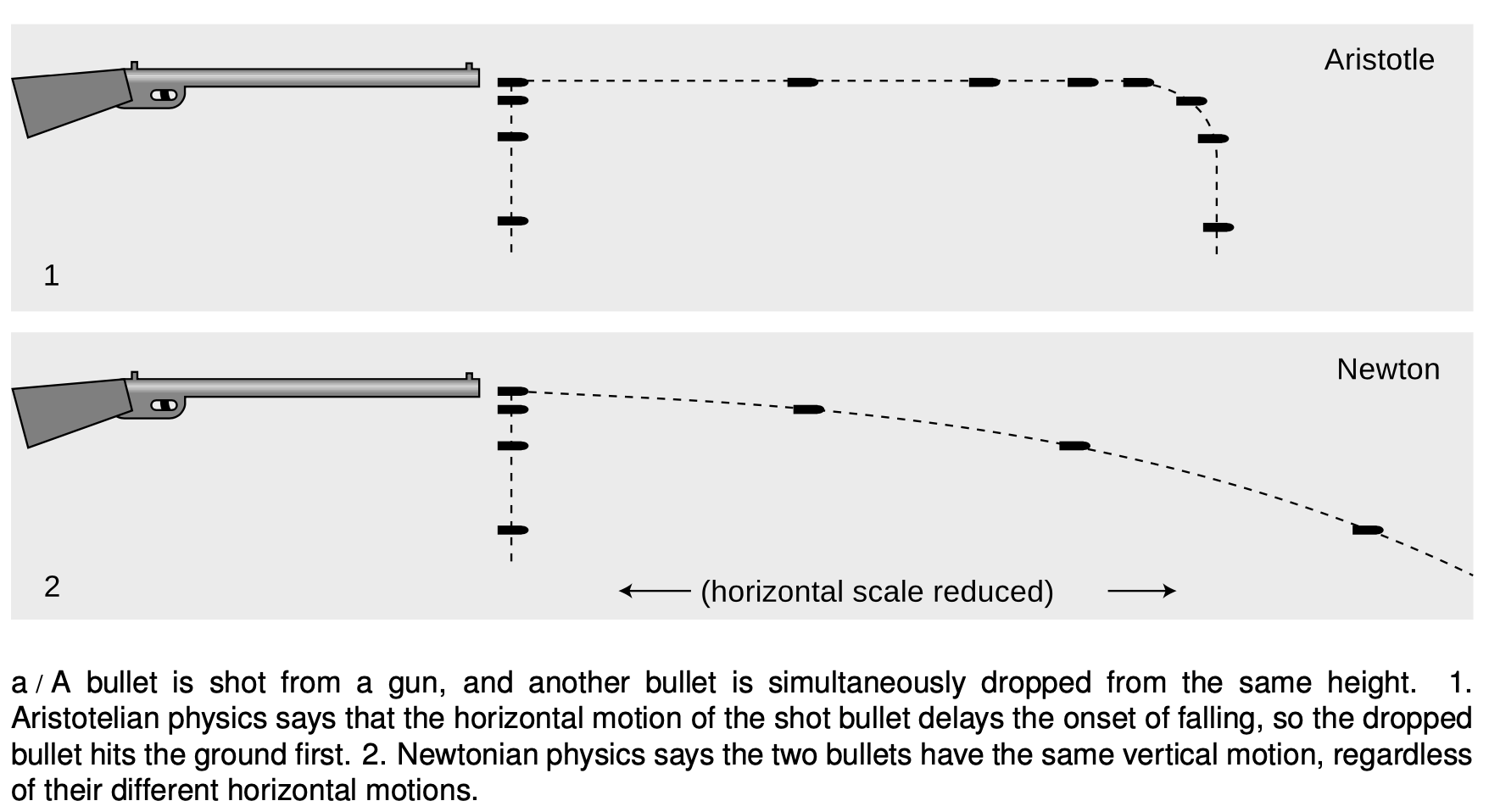6.1 Forces have no perpendicular effects by Benjamin Crowell, Light and Matter licensed under the Creative Commons Attribution-ShareAlike license.
6.1 Forces have no perpendicular effects
Suppose you could shoot a rifle and arrange for a second bullet to be dropped from the same height at the exact moment when the first left the barrel. Which would hit the ground first? Nearly everyone expects that the dropped bullet will reach the dirt first, and Aristotle would have agreed. Aristotle would have described it like this. The shot bullet receives some forced motion from the gun. It travels forward for a split second, slowing down rapidly because there is no longer any force to make it continue in motion. Once it is done with its forced motion, it changes to natural motion, i.e. falling straight down. While the shot bullet is slowing down, the dropped bullet gets on with the business of falling, so according to Aristotle it will hit the ground first.
Luckily, nature isn't as complicated as Aristotle thought! To convince yourself that Aristotle's ideas were wrong and needlessly complex, stand up now and try this experiment. Take your keys out of your pocket, and begin walking briskly forward. Without speeding up or slowing down, release your keys and let them fall while you continue walking at the same pace.
You have found that your keys hit the ground right next to your feet. Their horizontal motion never slowed down at all, and the whole time they were dropping, they were right next to you. The horizontal motion and the vertical motion happen at the same time, and they are independent of each other. Your experiment proves that the horizontal motion is unaffected by the vertical motion, but it's also true that the vertical motion is not changed in any way by the horizontal motion. The keys take exactly the same amount of time to get to the ground as they would have if you simply dropped them, and the same is true of the bullets: both bullets hit the ground simultaneously.

These have been our first examples of motion in more than one dimension, and they illustrate the most important new idea that is required to understand the three-dimensional generalization of Newtonian physics:
In the examples above, the vertical force of gravity had no effect on the horizontal motions of the objects. These were examples of projectile motion, which interested people like Galileo because of its military applications. The principle is more general than that, however. For instance, if a rolling ball is initially heading straight for a wall, but a steady wind begins blowing from the side, the ball does not take any longer to get to the wall. In the case of projectile motion, the force involved is gravity, so we can say more specifically that the vertical acceleration is , regardless of the horizontal motion.
self-check A:
In the example of the ball being blown sideways, why doesn't the ball take longer to get there, since it has to travel a greater distance?
(answer in the back of the PDF version of the book)
Relationship to relative motion
These concepts are directly related to the idea that motion is relative. Galileo's opponents argued that the earth could not possibly be rotating as he claimed, because then if you jumped straight up in the air you wouldn't be able to come down in the same place. Their argument was based on their incorrect Aristotelian assumption that once the force of gravity began to act on you and bring you back down, your horizontal motion would stop. In the correct Newtonian theory, the earth's downward gravitational force is acting before, during, and after your jump, but has no effect on your motion in the perpendicular (horizontal) direction.
If Aristotle had been correct, then we would have a handy way to determine absolute motion and absolute rest: jump straight up in the air, and if you land back where you started, the surface from which you jumped must have been in a state of rest. In reality, this test gives the same result as long as the surface under you is an inertial frame. If you try this in a jet plane, you land back on the same spot on the deck from which you started, regardless of whether the plane is flying at 500 miles per hour or parked on the runway. The method would in fact only be good for detecting whether the plane was accelerating.
Discussion Questions
`mathbf"A"` The following is an incorrect explanation of a fact about target shooting:

“Shooting a high-powered rifle with a high muzzle velocity is different from shooting a less powerful gun. With a less powerful gun, you have to aim quite a bit above your target, but with a more powerful one you don't have to aim so high because the bullet doesn't drop as fast.”
Explain why it's incorrect. What is the correct explanation
`mathbf"B"` You have thrown a rock, and it is flying through the air in an arc. If the earth's gravitational force on it is always straight down, why doesn't it just go straight down once it leaves your hand?
`mathbf"C"`. Consider the example of the bullet that is dropped at the same moment another bullet is fired from a gun. What would the motion of the two bullets look like to a jet pilot flying alongside in the same direction as the shot bullet and at the same horizontal speed?
6.1 Forces have no perpendicular effects by Benjamin Crowell, Light and Matter licensed under the Creative Commons Attribution-ShareAlike license.